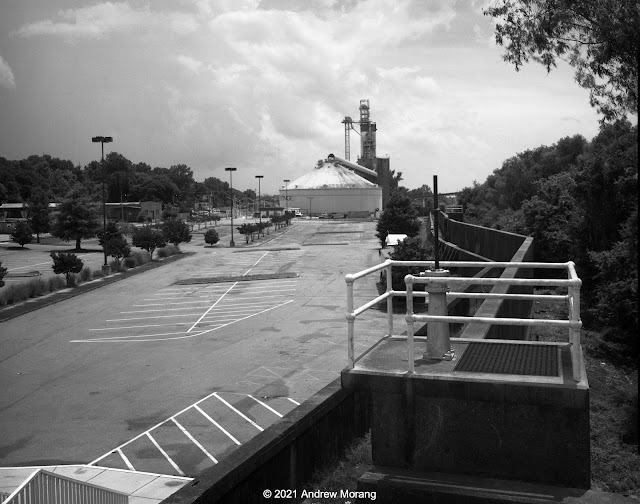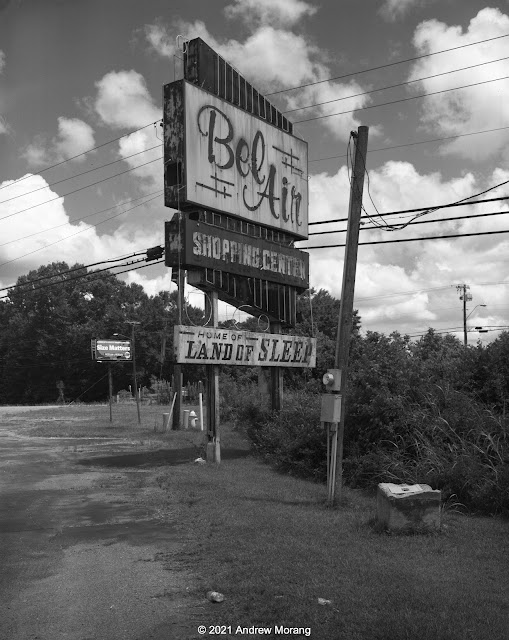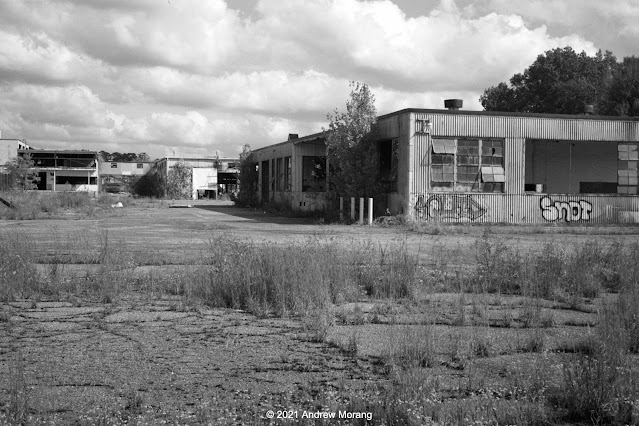 |
| Kodak Retina IIa, made in West Germany from 1951-1954 |
Background
The Kodak Retina was a highly-respected camera in the 1950s and 1960s. I never used one, but several friends said the lenses and output were excellent. So, in one of my occasional GAS (Gear Acquisition Syndrome) episodes, I started looking on the infamous eBay (now known as ePrey). Amazingly, some bargains in film equipment are still to be found there, but you need to be patient and look at the descriptions carefully. In early March (2022) this handsome little Retina model IIa (Type 016) came from a US vendor for all of $37, including shipping. It also included a medium yellow filter and a case. $37? How is this possible?
Retina Cameras
The most famous Retinas were folding cameras. This means the lens would pivot or fold into the body to make the unit more portable. You click a button to release the front door, and it swings open and shifts the lens into position. Before WWII and through the 1950s, folders were popular because they were compact. Medium format models tended to have problems with lens alignment, but 35mm models were smaller and more rigid. Zeiss Ikon, Agfa, Voigtländer, Certo, and other companies made various models. The finest may have been Voigtländer's
Vito III with its superb 50mm Ultron lens, one of the best 50s of the mid-20th century. But Kodak sold the largest number of folders.
By the mid-1950s, solid body cameras became the dominant design because the lens could be mounted more precisely and remain aligned over time.
Kodak made these superb little Retina cameras at their Nagel-werke subsidiary in Stuttgart, Germany. For reasons that I never understood, the mighty Eastman Kodak Company was unable to successfully make higher-end 35mm cameras in the USA. They made millions of snapshooter-level cameras for casual photographers, and their large-format lenses were well-respected, but precision 35mm cameras for enthusiasts eluded them.
Dr. August Nagel himself designed the original Retina in 1934. It held Kodak's 35mm metal film cassette, the same format that we still use today. Various Retinas of increasing sophistication followed for the next 35 years.
The models are confusing, and a Wikipedia article and retinarescue.com list the varieties of the post-war models in more detail than I can:
- I series. 1945-1960. Viewfinder folding cameras with ƒ/3.5 to ƒ/2 lenses.
- II series. 1946-1958. Nagel-werke added a rangefinder to improve focussing. My IIa is in this group and has a superb 50mm ƒ/2 Schneider Xenon lens.
- III series. 1954-1960. The most sophisticated models with both a selenium light meter and rangefinder. Most of the selenium meters have failed by now.
- The IIIc models allowed the front optical group to be exchanged with 35mm and 80mm groups. It was clumsy but worked.
- The IIIC (large C) models had an improved viewfinder and also accepted the interchangeable front lens elements.
- S series. Rigid bodies, 1958-1966. The IIIS used interchangeable lenses with the DKL (or Deckel) mount. They needed the S series lenses with a focus cam for the rangefinder. Beautiful cameras but very complicated internally
- Retina Reflex. 1957-1967. Totally different leaf shutter bodies. The Type 025 could use the same lens elements as the IIIc series above, while the later Reflex S used the DKL lenses. These did not successfully compete with Japanese reflex cameras in the 1960s. When working, they were excellent optically.
- Retinette series. These were lower cost with Reomar triplet lenses. Some of there bodies were almost identical to Retina bodies.
 |
| Retina IIa with front panel closed. The lens and shutter are protected. |
 |
| Coated Schneider-Kreuznach 50mm ƒ/2 Xenon lens (6 elements), approx. 1952-1953. Filter size: 29.5mm |
 |
| Shutter with range 1 sec to 1/500 sec. The distance scale is in feet for the US market. |
 |
| Film guide and spools - all precision machining |
My IIa has a 6-element
Schneider Xenon lens, a unit focus 6-element design. Unit focus means the entire lens moves forward and back as you focus. This lens is coated, as indicated by the blue tinge and the red arrow on the label. I assume this was a post-war computation, but the early-1950s would have been before the designers used computers for lens design. Rodenstock also supplied lenses for Retinas, usually the models sold in Europe. Notice the precision labels, metalwork, and mounting of the shutter and focus scale.
The filter size is 29.5 mm screw-in. Genuine German Kodak filters are thin enough to remain mounted when the lid is closed. Why do the most modern 50mm Über-lenses for mirrorless cameras need 67 mm or even larger filters?
More Information
You can find many reviews of Retinas on the web. They are popular with their current owners. I am surprised I do not see them in use. Of course, one rarely sees film cameras at all in use, but someone is buying them as well as film.
Cameraquest states that the IIa is his favorite model.
Photography & Vintage Cameras also prefers the IIa to other Retina models.
My friend, Jim Grey, loved his IIa but then let it go, which he now regrets (he will probably buy another one...). He also demonstrated the excellent optics of a IIc model.
Mike Eckman dot com wrote a detailed review of the IIa and a summary of the Kodak company's association with its German subsidiary. He has reviewed other Retina models, as well.
Random Camera wrote a good review of all German folders, with emphasis on the Retinas. He liked the IIa, too.
Photojottings described the superb and sophisticated Retina IIIC, the one with auxiliary lenses.
Is this Retina camera any good?
Well, that is the big question, of course. How is it optically? Here are some Kodak Gold 200 photographs from a recent trip to the Pacific Northwest. Click a frame to see 1600 pixels on the long dimension. You can judge for yourself, and I welcome comments, criticisms, insults, anything.
Olympia, Washington
 |
| Port of Olympia (next to the Dancing Goats® Coffee Tasting Room!) |
 |
| Swantown Marina, Port of Olympia |
The Food Bank serves hundreds in need in the Olympia area with food and other essentials.
 |
| Frog Pond Grocery in the historic South Capitol area (1/250 ƒ/5.6) |
Olympia is a nice little city at the south end of Puget Sound. You will see more Olympia photographs in the future.
Southwest Washington
Driving through rural Washington, interesting photo topics popped up and said, "Photograph me."
 |
| I am in the Danger Zone, Rte. 101, Skokomish (1/250 f/8) |
 |
| Fixer-upper hotel, 311 Main Street, Pe Ell, Washington (1/250 ƒ/11) |
 |
| Room with a view, Park Avenue, Aberdeen (the building really is curved; 1/100 ƒ/5.6½) |
Aberdeen has a wealth of delicious grunginess. It is on my return list.
Astoria, Oregon
 |
| Great blue heron, Columbia River, Astoria, Oregon |
Summary
This little Kodak Retina is a jewel of 1950s Germany precision manufacturing and optical excellence. I certainly can't complain about the lens resolution or body rigidity. Imagine the skill of the technicians who assembled these cameras on workbenches.
On mine, the rangefinder was cloudy and a bit out of alignment. I sent it to Paul Barden in Corvallis, Oregon, for a thorough cleaning and adjustment. After seven decades, I need a cleaning and adjustment, too! Mr. Barden said the camera was in good condition and minor fungus in the rear group cleaned off without etching the coating. The rangefinder is rather squinty and is not as brilliant and clear as one in a Leica M, but what do you expect?
The leather case was seriously stinky, but I washed it and re-glued the lining to the outer shell. It works well, although normally I am not a user of camera cases. I also fixed four "Zeiss bumps", bumps where rivets under the leather build up a blob of tarnish.
These Retinas are still somewhat inexpensive on the 'Bay. When will they become the next trendy in-thing for film photographers? Buy before the prices go up, and enjoy.
Update July 2022: The cleaned and overhauled the IIa is home. Now I need to make time to use it. Here are
photographs of Houston, Texas, in November of 2022.

















































